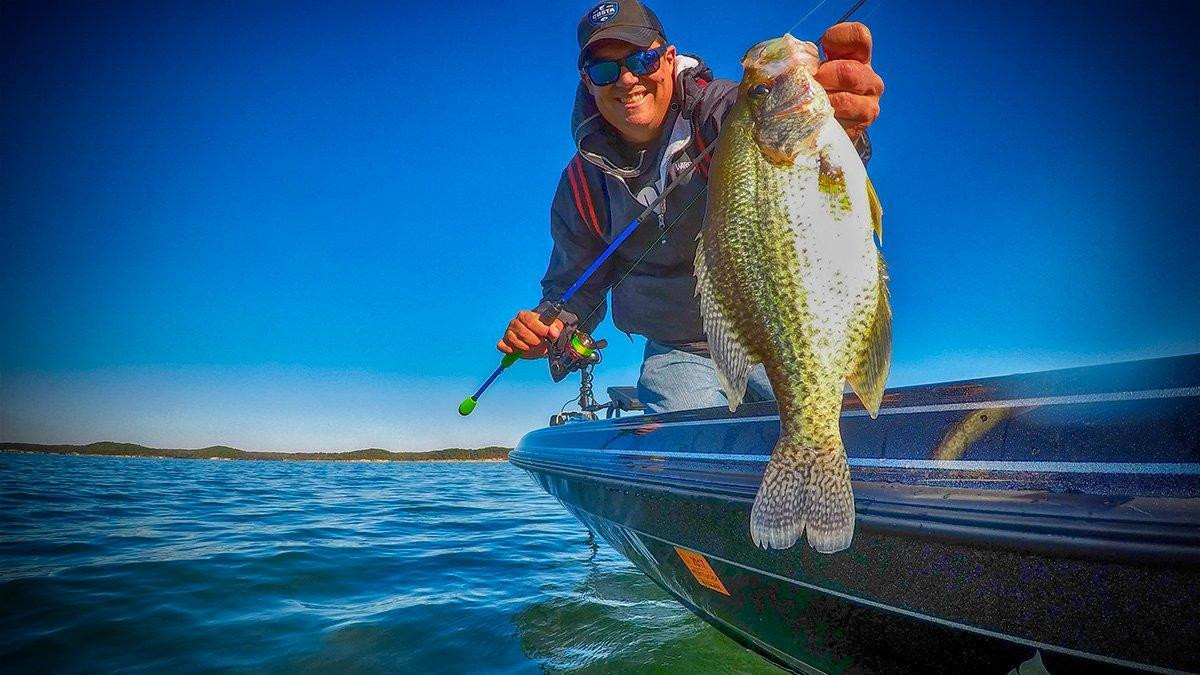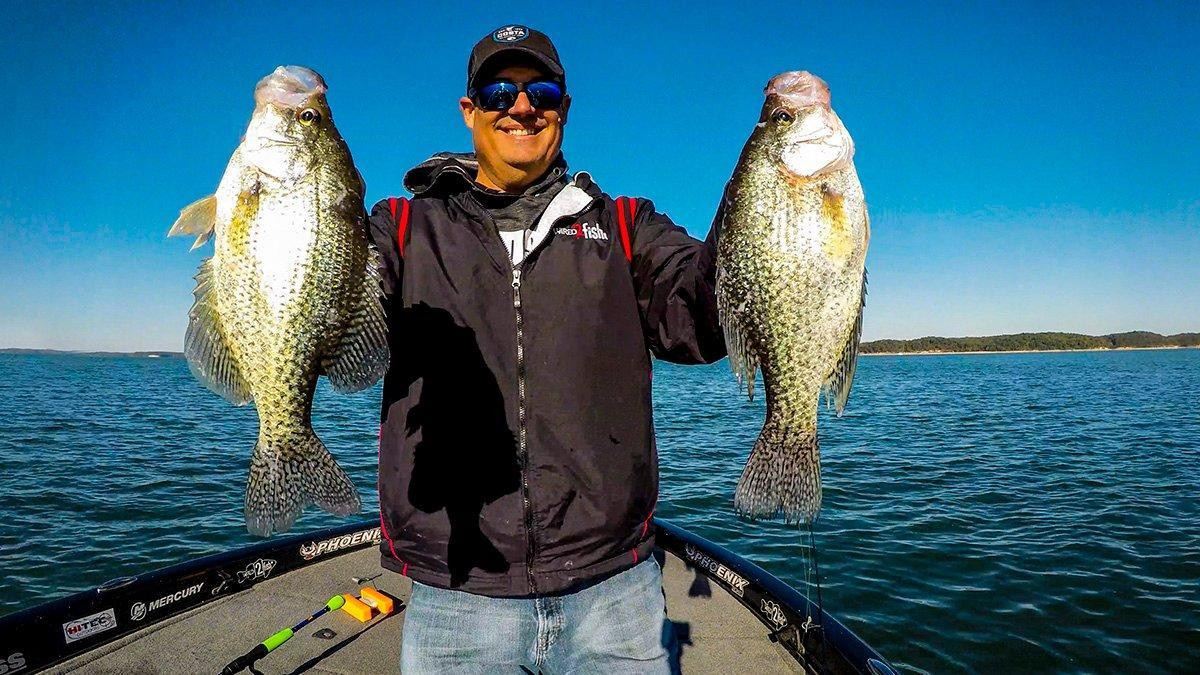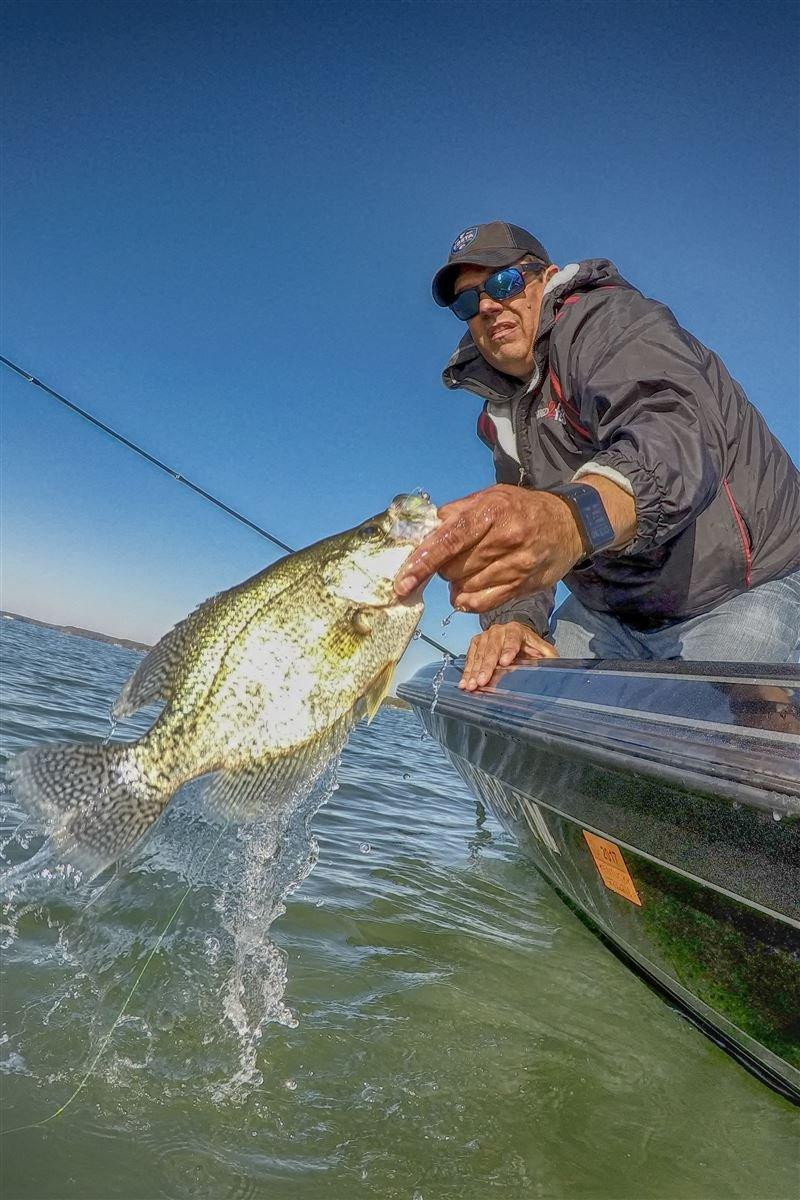I’ve probably had more fun learning crappie fishing and becoming more adept at not only finding crappie but learning what seems to work and not work and when certain retrieves work better than others. I can say that how crappie react isn’t completely different than how a bass might react to a lure presentation but there are some nuances that seem to be the norm with crappie the more I’ve fished for them in the last couple of years. And I’ll preface this gallery with the fact that there are many good crappie anglers that have forgotten more about crappie than I will probably ever learn. But still I enjoy the process of figuring out fish and like to share my experiences with other anglers who like to figure it out with a little direction themselves.
Straight reel
The simplest thing I think for people to do with a crappie jig is just cast it out as far as you can and reel it back slow and steady. Slow is relative to your spool speed. That’s what I look at when I start reeling the jig. Actually, I cast as far as I can, and if I’ve seen a school of crappie on the graph before hand or am casting to a known piece of cover, I will watch my line because a lot of bites happen on that initial fall.
But I count the jig down to the depth I want to fish and the start reeling slowly. I watch the spool on my spinning reel to see how fast the line is winding onto the spool. That sets my speed. I want it to be moving the jig inches per second not feet per second. Afterall I’m trying to keep a 1/16 ounce jig at depth most of the time. Sometimes I will stop reeling briefly to let the jig get back down in that depth zone. But I’m trying to bring it back over the cover or school at one continuous depth.
It definitely takes practice and time to learn to keep the jig down with a slow crawl. As the wind gets up, you’ll be forced to go up on weight because the drag on the line will cause the jig to rise shallower in the water column.
Tight lining
Often when I find a school of crappie on piece of brush on a steep break, they will often be off the deep side hanging off the cover. At least that is my majority of experience on Kentucky Lake. Sometimes they are on top of the cover and a straight retrieve works well. But when they drop off the deep side of a piece of cover, it can be hard to come over the top of cover and then get down into the school. I usually accomplish this by tight lining the jig and plastic down over the cover and let it continue to fall next to the cover out into deeper water. So it is working back to me but also falling deeper as it goes.
The key is to position your boat in deeper water or basically cast shallower and let it pendulum out into deeper water. Recently that has been working well for me as the crappie are still pretty deep on cover and down around the bass on the break. I like the lightest jighead I can get away with because you might catch the top of the cover and you can use another retrieve — the pull — to get your jig over and then tightline down through the fish.
A heavier jig hangs more. Just a fact of fishing around wood cover.
The Pulse
It’s hard to call vertical fishing a retrieve. But there is an art to it. I’ve been with some pretty good crappie anglers and they have definitely mastered the art of getting a jig to stay deep and still have an enticing action. I call it a pulse. They don’t hop the jig up real high in the water. They almost give the rod tip a heartbeat like pulse. Just pulse the rod tip up a few inches and let the jig settle. Hold it a few seconds. Then pulse agin. The bite happens most often after you pulse, let it get back to depth and sit still for just an instant. It’s like they see it move, turn towards it. And then as they see it sitting there still they suck it in.
It’s really effective when the fish are down in the cover and casting will get you hung more often than not. I will keep little weights to knock my jig loose if I do get hung vertical pulsing. See how I get them loose here.
The other thing about the pulse is it’s a great tool to employ on the initial cast with a steady retrieve or in tight lining. Just give the jig a little pulse as it falls. You will be surprised how often that is when the strike occurs on a drop, a tight line and vertically fishing. There is something about a crappie that actually wants to hit a jig at the inaction right after an action. I usually think about my move is just to get the crappie’s attention and then wait for him to bite after I got his attention.
Suspended inching
This is probably the weakest part of my crappie game. Some guys are really good at it. They will basically put a bobber on the line a foot or two above a jig and just inch the bobber along on the surface moving the crappie jig but keeping it at a shallow depth the whole time. When crappie are really high in the water column or in shallow water, this is a deadly retrieve. I just don’t have a ton of experience at it. But I’ve seen other guys just rip them doing it. It’s something I want to experiment with more but it seems like the weather always seems to mess up our shallow fishing around these parts lately.
The key as I’ve seen is to reel the bobber fast enough to keep constant motion but not so fast that the jig slides up high and behind the bobber. You want to just inch it along. The bobber you choose can affect how the jig rides in the water as can the weight of the jig. I still think the lightest jig you can get away with is the best. So play with some bobbers and see what works for your retrieve. Most guys use simple clip on bobbers in shallow water and slip bobber rigs when using this retrieve a bit deeper in the water column.
The pull
The pull is something I’ve seen work the last several years when fishing for crappie around brush. You can do it on a straight retrieve and when tight lining over brush. Your jig will sometimes land over a branch and if you learn to feel that bit of extra tension on your line, you can learn to pull the jig over and let it fall off the cover. That has also been very effective lately as the fish have been right on the edges of the cover. If you can clear the cover around crappie, you get a bite nearly every time.
It’s definitely not fool proof, and it becomes increasingly difficult as the wind blows. Again you have to be willing to sacrifice a few jigs. The biggest thing is not to pull hard into the cover or jerk the rod. If you can master raising the rod and just pulling the jig up and over, it will often come over clean and you get a bite as soon as you give the jig slack again.
My other thoughts on crappie retrieves
So that’s my take on the 5 most useful crappie retrieves for fishing jigs for crappie. It’s worked well for me the last several years as I’ve loaded coolers, freezers and dinner tables with delicious crappie for my family and friends. I’m fortunate to live on a lake where I can experiment a lot with tackle, technique, location, seasonality and more with an abundance of willing fish.
You should learn about the different crappie jigs available. I’ve talked at length about my choices in plastics and how I find the crappie most of the time. But I’ve also paid attention to how the fish react in different situations and conditions and how to best get a bite on various retrieves. There is definitely something to be said about a crappie wanting the bait to sit more than it moves. To move enough to get its attention but then to allow it time to grab it while it moves naturally. That’s one of the reasons I think a 1/16 ounce jig is superior to a 1/8 ounce jig in most cases. It’s also why I like a good sensitive rod and use 4-pound line most of the time too.
I’ve been playing with the new Mr. Crappie Speed Shooters from Lew’s this year and really like them so far as well as the Jenko Fishing Hypersense Marksman and 7-foot Medium Light rods for most casting applications. I will use them vertical jigging but that’s more because I cycle through retrieves on a lot of spots where I might start straight reeling from a distance then inch in closer and start tight lining and pulling before finally getting on top of the spot and pulsing from a vertical position. One 6 or 7-foot rod allows me to do all of that.

















